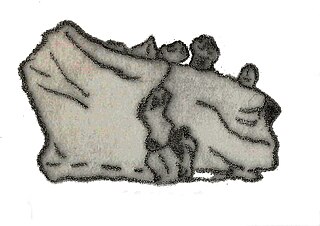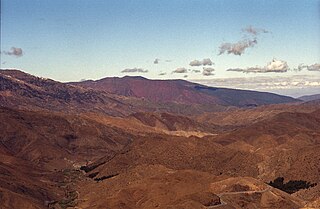The Triassic is a geologic period and system which spans 50.6 million years from the end of the Permian Period 251.902 million years ago (Mya), to the beginning of the Jurassic Period 201.36 Mya. The Triassic is the first and shortest period of the Mesozoic Era. Both the start and end of the period are marked by major extinction events. The Triassic period is subdivided into three epochs: Early Triassic, Middle Triassic and Late Triassic.

Découvertes Gallimard is an editorial collection of illustrated monographic books published by the Éditions Gallimard. The books are concise introductions to particular subjects, intended for a general audience but written by experts.

The Glypheoidea, is a group of lobster-like decapod crustaceans which forms an important part of fossil faunas, such as the Solnhofen limestone. These fossils included taxa such as Glyphea, and Mecochirus, mostly with elongated chelipeds. This group of decapods is a good example of a living fossil, or a lazarus taxon, since until their discovery in the 1970s, the group was considered to have become extinct in the Eocene. The superfamily Glypheoidea comprises five families. The two extant species, Neoglyphea inopinata and Laurentaeglyphea neocaledonica, are both in the Glypheidae.

Fabrosaurus is a genus of ornithischian dinosaur that lived during the Early Jurassic. It was originally placed within the now obsolete family Fabrosauridae.

Sinosaurus was a theropod dinosaur which lived during the Early Jurassic Period. It was a bipedal carnivore approximately 5.6 metres in length. Fossils of the animal were found at the Lufeng Formation, in the Yunnan Province of China.

Lapparentosaurus is a genus of sauropod dinosaur from the Middle Jurassic. Its fossils were found in Madagascar. The type species is L. madagascariensis.
Breviparopus is the name given to an ichnogenus of dinosaur, having been made by an unknown genus of sauropod. As an ichnogenus, the taxon is represented by a 90-metre (295 ft) long series of fossil tracks, or ichnites, found in the spring of 1979 in the Atlas Mountains of present-day Morocco. At the time, this area would have been part of the splitting Gondwana supercontinent. The animal that produced the Breviparopus tracks is rumored to be one of the largest dinosaurs, though its exact size has been the subject of much debate.

The Argana Group is a geological group in the western High Atlas northeast of Agadir, Morocco. It dates back to the Late Triassic. The group contains the Timezgadiouine Formation.

The Marnes de Dives is a geological formation in Normandy, France. It dates back to the upper part of the Callovian stage of the Middle Jurassic. And is partially equivalent to the Oxford Clay in England. It predominantly consists of ooidal marl, rich in pyrite and lignite, interbedded with thin limestone horizons. It is best exposed at the base of the Falaises des Vaches Noires as well as the foreshore at low tide. It is known for its fossils, notablity those of ammonites, marine crocodiles and fragmentary remains of dinosaurs, mostly theropods.

The Isalo III Formation is a geological formation in Madagascar, off the eastern coast of Africa. It dates back to the Middle Jurassic. The use of the term "Isalo III" is somewhat controversial as the two prior units Isalo I and II are Triassic cross-bedded sandstone units that form a continuous depositional sequence, while the "Isalo III" sandstones are not part of the same depositional sequence, and were deposited considerably later. and are perhaps better treated as part of several separate formations. It is traditionally divided into two subunits the lower, Bajocian aged Isalo IIIa unit also known as the Beronono Formation and the upper, Bathonian aged Isalo IIIb unit also known as the Sakaraha Formation or Sakahara Formation. The Sakaraha Formation consists of sandstones, marls and carbonates and represents a coastal plain environment, and is laterally equivalent to the predominantly carbonate Bemaraha Formation, which represents a coastal barrier lagoon complex. The formation is found in the northwest and in the southeast of the country and has provided a variety of fossils.
Tizi-n-Aït tracksite is a fossil trackway location in Morocco in the Azilal province. It is Jurassic in age, with tracks attributed to sauropods or stegosaurs, and an unidentified carnosaur. The tracksite is part of the Aganane Formation and the tracks are located at base of formation.

The Aganane Formation is a Pliensbachian geologic formation in Morocco. Fossil stegosaur and theropod tracks have been reported from the formation.

The Assaouas Formation, also referred to as the Assaouas Sandstone is a Late Jurassic geologic formation in Niger. Fossil sauropod tracks have been reported from the formation.

The Festningen Sandstone is an Early Cretaceous (Barremian) geologic formation in Svalbard, in the far north of Norway. Fossil ornithopod tracks have been reported from the formation.
Sphingopus is an ichnogenus of dinosauromorph footprints found in sediments dating to 250 and 228 Ma. The exact species which created the Sphingopus tracks have not been identified.

Pentasaurus is an extinct genus of dicynodont of the family Stahleckeriidae, closely related to the well known Placerias. It was found in the Lower Elliot Formation of South Africa, dated to the Norian of the Late Triassic period. The genus contains the type and only species, Pentasaurus goggai. Pentasaurus is named after the ichnogenus Pentasauropus, fossil footprints that were originally described from the lower Elliot Formation in 1970 decades before the body fossils of Pentasaurus itself were recognised. Pentasauropus footprints were likely made by dicynodonts, and in South Africa Pentasaurus itself was the likely trackmaker. The name reflects the fact that a large dicynodont was predicted to have existed in the lower Elliot Formation before any body fossils were recognised, and so Pentasaurus was named after its probable footprints. This is a reversal of the more typical occurrence where fossil footprints are named after their presumed trackmakers. The name of the species honours its collector Alfred Brown, nicknamed "Gogga", which means "bug" in Afrikaans.

The Azilal Formation, also known as Toundute Continental Series and Wazzant Formation, is a geological unit in the Azilal & Ouarzazate provinces of the High Atlas of Morocco, that cover the early Toarcian to early Aalenian stages of the Jurassic Period. It is a terrestrial deposit which overlies marine dolomites of equivalent age to the Budoš Limestone of Montenegro or the Marne di Monte Serrone of Italy. Dinosaur remains, such the sauropod Tazoudasaurus and the basal ceratosaur Berberosaurus are known from the unit, along with several undescribed genera. The Units inside the group have been considered individual on the past, being a division of the so-called "Couches rouges", and subdivided by a supposed geological scale. The strata of the group extends towards the Central High Atlas, covering different anticlines, and topographic accidents along the range of the Mountains. Although new studies have suggested that the strata is coeval in age, and should be referred to as a unique unit. The Group is believed to have been a mostly deltaic, and river channels filled a succession of seashore and inland environments, covering the late Liassic coast of modern northern Africa. Based on observed halokinetic strata, the Tazoult Ridge evolved as a Salt Wall forming a 20 km long NE-SW trending structural and sedimentary high for at least 20 million years, between Pliensbachian-Bajocian periods. This emerged small landmass generated a great local diapir, with continuous Diapirism until the end of the Aalenian.
Kholumolumo, formerly "Kholumolumosaurus" or "Thotobolosaurus", is an extinct genus of massopodan sauropodomorph dinosaur, which was closely related to Sarahsaurus, from the lower Elliot Formation of Maphutseng, Lesotho. The type species, Kholumolumo ellenbergerorum was formally described in 2020.

Narindasaurus is a genus of turiasaurian sauropod dinosaur from the Middle Jurassic Isalo III Formation of Madagascar. The type species, N. thevenini was formally described by Royo-Torres et al. in 2020. The holotype, which consists of one specimen, is currently stored at the Muséum national d’Histoire naturelle and has been since 1906 or 1907.












